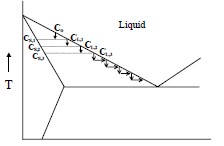Abstract
The thermo-physical and physical properties of the liquid and solid phases are critical components in casting simulations. Such properties include the fraction solid transformed, enthalpy release, thermal conductivity, volume and density, all as a function of temperature. Due to the difficulty in experimentally determining such properties at solidification temperatures, little information exists for multi-component alloys. As part of the development of a new computer program for modelling of materials properties (JMatPro) extensive work has been carried out on the development of sound, physically based models for these properties. Wide ranging results will presented for Al-based alloys, which will include more detailed information concerning the density change of the liquid that intrinsically occurs during solidification due to its change in composition.
Introduction
Casting of Al-alloys is one of the most important features of Al technology and the increasing use of process modelling software to design and optimise castings makes it important that the thermo-physical and physical properties of Al alloys are well characterised, as they are critical input for almost all types of process models. Obtaining these properties at low temperatures can be a time-consuming and expensive procedure if all relevant properties are considered. Experimental measurement becomes more problematical at high temperature, especially if the liquid phase is involved. To this end it is highly desirable to calculate thermo-physical and physical properties over the whole solidification range for as wide a range of alloys as possible.
The present paper describes a general methodology to calculate properties such as density, thermal conductivity, specific heat (Cp), solidification shrinkage etc. for multi-component alloys. The property models that are described in the present paper have also been linked to the simulation of non-equilibrium solidification based on the Scheil-Gulliver (SG) model. Hence it is possible to directly input calculated values into casting simulation packages.
The current work forms part of the development of a more generalized software package (JMatPro) for the calculation of wide ranging of materials properties [1]. A feature of the new program is that great store has been placed on using models that, as far as possible, are based on sound physical principles rather than purely statistical methods. Thus many of the shortcomings of methods such as regression analysis can be overcome. For example, the same model and model parameters are used for density calculations for all alloy types, whether it is for a commercially pure Al or a complex Ni-based superalloy.
The paper will describe the SG solidification model that directly calculates fraction solid, Cp, enthalpy and latent heat of solidification. Details concerning the creation of a molar volume database that enables a variety of properties to be calculated, such as solidification shrinkage, density, thermal expansion coefficient, will then be presented. The calculation of thermal conductivity will also be discussed. Examples of the linking of the solidifi-cation models with the physical property calculations will be made and properties during solidification will be calculated for a series of Al-alloys and the results presented. A significant advantage of the current method is that properties for each phase are calculated so fine detail can be obtained; for example the density change of the liquid during the solidification, which is governed both by an intrinsic change as the temperature is changed and also by the composition changes that accompany solidification.
``````
